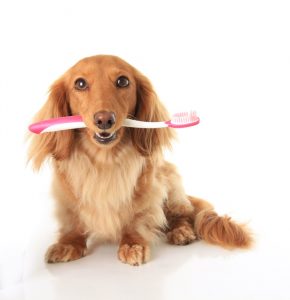How About Fido’s Teeth?
If you’re thinking about adding a pet to your family this holiday season, then you have probably done your research on proper food, training, and living conditions. While most pet owners diligently take their pet to their yearly exam at the vet, some forget the importance of a pet’s oral health between scheduled appointments! Just like their human counterparts, dental disease can strike our furry friends as well. Oral hygiene is a vital component to an animal’s overall wellness and comfort level. To keep your pet’s mouth in good condition, we have outlined easy steps to take to ensure their needs are taken care of.
Brushing teeth
Veterinarians agree that brushing your pet’s teeth is the single most effective way to maintain good oral health between regular dental exams. Just like in humans, plaque can from in the gum lines of pets and lead to periodontal diseases that can result in pain and tooth loss. For the dogs in our life, toothpastes come in flavors that are appealing to them, such as seafood and poultry. Not quite the minty fresh feeling we’re accustomed to, but Fido will be thrilled!
It’s important to avoid using human toothpaste on pets, since the ingredients can be harmful if ingested—and most of our pets will be inclined to do just that. Additionally, be sure to purchase a pet-specific toothbrush that will help you reach the odd angles of their mouth. If your pet seems to experience pain while you brush, they might already be suffering from a dental disease, and it’s important you get them into the vet as soon as you can.
Regular dental exam
Dental exams for dogs and cats are generally performed under full anesthesia and are recommended every year for small breeds and every two years for larger breed dogs. It’s recommended that pets be fully put under anesthesia in order to have a full, comprehensive cleaning. In order to remove all the plaque from the gum line without causing your pet undue stress or pain, it’s essential that they be asleep. Anesthesia-free exams simply clean the surface of the tooth. The scraping done in the exam leaves grooves, also, which are susceptible to bacteria build up and future dental issues. While under anesthesia, your pet will be closely monitored, and you’ll be given instructions on their post-appointment care. So, there will be nothing to worry about in the hands of your pet’s vet!
Products to promote oral health
While the old adage is that a dog’s mouth is cleaner than a toilet bowl, it is still best to do anything you can to promote good oral health in your pet. Consider giving your dog chew treats or rawhide products that contain anti-tartar ingredients. Ideally, you would create a daily “chew toy” routine which can help protect your pet’s mouth. In addition, massage your pet’s gums to help keep them clean. By getting them comfortable with you touching their mouth, will lead to easier toothbrushing sessions, too.
We often forget that our pets are susceptible to the same dental diseases that we are. While we can easily identify a problem, our pets are not always able to show exactly where their pain is located. By ensuring your pet is receiving regular dental exams, coupled with a daily brushing routine, you will be able to avoid problematic dental diseases. Your animals are a member of your family, so make sure they have good oral health routine, too!






